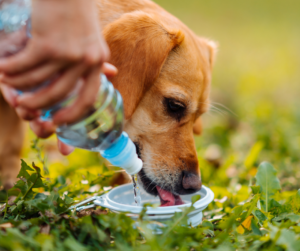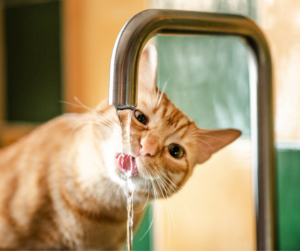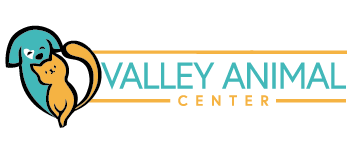Are your pets drinking enough water?
Do you know how much water your pets drink? On average, your dog should drink a half to one ounce of water per body pound of body weight. In comparison, cats need about 3.5 to 4.5 ounces of water for every five pounds of body weight. If you have kittens and puppies, they may even drink more due to their growing age and higher metabolism. If your pets don’t get enough water, they may be at risk of becoming dehydrated!
As the hotter seasons come around, it’s even more important for you to monitor your pet’s hydration level. Just like humans, your pet’s bodily functions require water, and a dehydrated pet can quickly become ill or weak.
Depending on whether you have a dog or cat, here’s what you need to know about your pet’s hydration!
DOGS
 Dogs in general drink about 1 ounce of water per pound of their body weight. Unlike cats, dogs, on average, are more eager to drink water when they are thirsty. Because of this, you may not necessarily need to monitor their water intake (unless your vet has asked you to do so). However, it’s still good practice to pay attention to the general amount of water your dog is drinking. Again, just like with cats, any significant changes in water intake, whether they are drinking LESS or MORE water, can be a sign that something may need to be checked!
Dogs in general drink about 1 ounce of water per pound of their body weight. Unlike cats, dogs, on average, are more eager to drink water when they are thirsty. Because of this, you may not necessarily need to monitor their water intake (unless your vet has asked you to do so). However, it’s still good practice to pay attention to the general amount of water your dog is drinking. Again, just like with cats, any significant changes in water intake, whether they are drinking LESS or MORE water, can be a sign that something may need to be checked!
Here are some ways for you to ensure your dog stays hydrated every day!
- Have easy access to water! Make sure you have water bowls in areas that your dog typically plays or rests in. Easy access will encourage your dog to drink water when they are feeling thirsty. If they have to hunt for water, they may decide it’s more fun to just keep playing or to just lay down and rest instead of hydrating themselves!
- Leave your dog’s water in cool areas. Majority of dogs like their water cool, so have your dog’s water bowl in a cool and shaded area. Outdoor water bowls should be checked and changed frequently during the warmer and hotter seasons so that your dogs continue to receive cool water throughout the day. You can even throw in some ice cubes for an extra chill!
- Have water ready on the go. When taking your dog out on a walk, or going into a play area like a park, make sure to bring a water bowl and water. It’s a good idea to scout the area you will be taking your dog and see if there will be available water. You don’t want to be in a situation where your dog is thirsty and there’s no water around! PS: If you take your dog out for a run and they drink water right after, make sure to control just how fast your dog is drinking water! Drinking water too fast may induce your dog to vomit!
- Clean your dog’s water bowl! You should be washing your pet’s water bowl daily with soap and water. Throughout the day, also check if your dog’s water bowl had debris or hair floating in it. An unappetizing water bowl does not do well in encouraging your dog to drink from it!
- If your dog only eats dry food, you can consider giving them some canned wet food. Canned food is about 65%-80% water, so this is another source of hydration for your dog. If your dog is already eating wet food, you may also notice that they may not drink as much water since they’re all ready getting a water source from their food!
CATS
 Cats, on average, need less water than dogs, but it can sometimes be harder to know if your cat is even drinking water since you may not be able to see them when they do!
Cats, on average, need less water than dogs, but it can sometimes be harder to know if your cat is even drinking water since you may not be able to see them when they do!
Here are some ways you can check to estimate if your cat is staying hydrated!
- Change the water bowl every day and track the amount it has decreased. Make sure you fill up the water bowl to the same level each time so it’s easy. This is not only great practice, but it may also help you see if there’s been significant changes. Generally, significant changes that stray from your cat’s normal pattern of behavior is something you want to pay attention to and monitor.
- If your cat loves their wet food, they may be getting the hydration they need! Wet cat food comprises about 70%-80% of water, so an average 5.5 ounce can of wet cat food can already give your cat about 3-4 ounces of water!
- Check your cat’s litter boxes daily and take note of their urine and defecation! Are they using the litter box less than usual? Peeing and pooping uses water from your cat’s body and your cat will need to rehydrate themselves to ensure future healthy bodily functions!
- If your cat has recently vomited or had diarrhea, it’s much easier for them to become dehydrated! If this has recently happened to your cat, it’s even more important for you to make sure they rehydrated themselves through water or wet food.
HELP! How can I get my cat to drink water?
- Have more water bowls placed throughout your home. To pique your cat’s curiosity, also try having different shapes and sizes of the water bowls. Try a glass cup, colorful mugs, and so forth, and place them in different areas. A curious cat may be attracted and wander to these water bowl alternatives and take a few licks!
- Are you using tap water? Maybe experiment with filtered water or bottled water. Just like humans, cats can be picky about the water they like! You can even try adding a little bit of flavor through a small amount of low-sodium chicken broth (that doesn’t have onion or garlic).
- Use ice cubes! Cats are curious creatures. Bobbing ice cubes in water may fascinate them enough to take a lick. Don’t underestimate the power of a few licks here and there! They will accumulate over the day.
- Consider utilizing a water fountain. The sound of flowing water may attract your cat to drink and perhaps even play around with the water!
- Clean the water bowls! Just like how you wouldn’t want to drink from a dirty cup, your cat also doesn’t want to drink from old water or dirty water bowls. Remember, your cats are sensory creatures, so their sense of smell is much stronger than ours. If the water bowl smells dirty, they will be less inclined to drink from it!
Whether you have a cat or dog, it’s important to remember that excessive water intake can be just as harmful as not enough water intake. Of course, all dogs and cats are also individual beings. If you have multiple pets, you might worry that one of your pets isn’t drinking as much as the other. This doesn’t necessarily mean something is wrong. The important thing is to understand what is “normal” for your pet, and this will require you to do some investigating! Once you understand how much water your pet typically takes in, you can then understand if your pet is suddenly drinking too little, or too much, water than what is typically normal for them. If you ever have any concerns about your pet’s hydration level, don’t hesitate to contact your vet!
This blog is republished from Valley Animal Center’s “Beat The Heat” campaign. The campaign aimed to inform and educate pet owners on ways to keep their pets hydrated and safe during the hot seasons. During the summer seasons, the Central Valley witnesses several heat waves and our dry and hot weather can pose dangerous threats to our animals and their owners. Valley Animal Center is here to provide impactful information and services to pet owners in order for owners to become better informed on ways to keep their pets healthy and safe.
–
Valley Animal Center is dedicated to serving animal companions in the Central Valley and beyond. Our mission is to unite dogs and cats with loving people. We believe every animal deserves a loving family and furever home. Donate to support our endless mission as we care for hundreds of homeless dogs and cats throughout the year.


